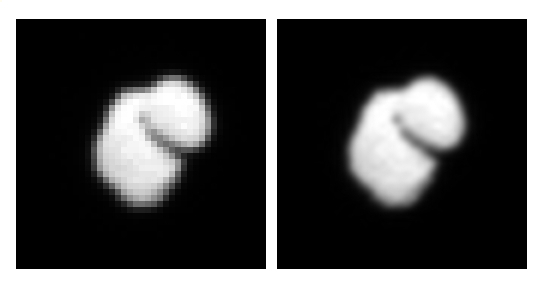Cosmic Duckie, You’re the One ...

(With apologies to Ernie.)
Right now, in deep space 400 million kilometers from Earth, the European Space Agency probe Rosetta is easing its way toward the comet called 67P/Churyumov-Gerasimenko (which, for obvious reasons, I’ll just call ChuGer). On July 14 it was a mere 12,000 km (7400 miles) from the comet—less than the diameter of the Earth! It took a series of images of the frozen ice ball, and it’s becoming very clear that this comet is really, really weird:
It’s not an ice ball … it’s an ice rubber duckie! And a big one, about 4 kilometers across.
As you can see, it appears to have two distinct components; a large, flattish piece and a smaller, rounder one attached off-center. You can see this a lot more clearly in an animation composed of 36 images taken about 20 minutes apart:
What the what? Note that the comet is only a couple of dozen pixels across as seen by Rosetta; the images in the animation (and on the right in the still image above) have been smoothed to give you an idea of what it looks like. Don’t take small details too literally, but the overall shape is apparently real.
It’s not clear why it has this shape, but there are several possible explanations of how it may have been molded this way.
Comets are big lumps of frozen water with dust and rocks mixed in. In fact, we sometimes call them “dirty snowballs.” It’s possible that two comets suffered a very low speed collision and stuck together, forming the weird shape.
However, that strikes me as very unlikely. Why? Space is big. That’s why we call it “space.” The odds of two comets coming that close together at just the right speed and angle to do this seem very low to me.
It’s more likely, in my mind, that ChuGer got whacked by a much smaller object, say a chunk of asteroid. Some comets aren’t solid, like rocks, but more like loosely bound rubble piles held together by the ice. Over the eons, small impacts would shatter it, creating deep cracks inside the comet. A slightly bigger collision could actually dislodge large chunks. If the impact speed were right, the big chunks might separate a bit and then slowly re-accrete over time due to their feeble gravity. What you’d get is a weirdly shaped object, like if you took a small snowball and stuck it on the side of a bigger one.
Which is just what we see with ChuGer. I’m totally guessing here, but I have a sneaky suspicion that’s what we’re seeing.
Another way it could have gotten this shape is that it used to be rounder and smoother, but over time eroded away. Comets have lots of ice, and as they approach the Sun that ice turns directly into a gas (which is called sublimation) and streams away. Anything less volatile (like rocks inside) will remain. If the comet has big lumps of rock inside it, or just big pockets of ice distributed through it, it could erode asymmetrically, leaving huge lumps like ChuGer’s.
Again, I’m guessing. We’ve only visited a handful of comets by spacecraft, and to be honest they’re all weird. Halley is a lumpy potato. Hartley 2 looks like a bowling pin or a dumbbell, with lobes made of carbon dioxide and a waist of frozen water. Other comets have been found to be similarly lobed, lumpy, and basically asymmetric.
The whole point here is that we’re exploring—we don’t know what we’ll find. If we did, it wouldn’t be exploring.
And we’ll find more, much more. Rosetta is still approaching ChuGer, and in early August will be a mere 100 km (60 miles) from the comet. It will enter orbit, examining the nucleus (the solid part of the comet) in excruciating detail. Then, in November, it will send out a lander named Philae to physically touch down on the comet’s surface! It will examine the comet and send the data back to Earth via Rosetta. Its planned mission will last about a week, and should be a huge bounty for astronomers and planetary scientists.
Over the next weeks I’ll be writing more about this amazing mission and the strange comet it’s studying. ESA doesn’t have the same policy of freely releasing images that NASA does, but hopefully when something new and spectacular is available, you’ll be able to read all about it here.
In the meantime, you can take a look at some of the amazing highlights from the Rosetta mission so far, including some jaw-dropping images of Earth, Mars, an asteroid named Lutetia (with a fantastic gallery), another lumpy diamond-shaped asteroid named Steins, and a lovely shot of the Moon rising over the limb of the Earth. These images show the promise of what we’ll see very, very soon once Rosetta is in orbit around 67P/Churyumov-Gerasimenko.



